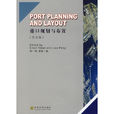內容簡介
本書主要介紹港口規劃與布置所涉及的港口營運、港口規劃調查及分析、碼頭及水域布置、陸域設施、港口發展規劃以及環境評價與環境保護等問題。它可作為港口航道與海岸工程專業本科生英文版教科書,亦可作為土木、水利、交通運輸類專業的港口課程英文版教材。對從事港口規劃、建設、技術管理和港口經營以及從事交通運輸綜合管理的工程師、經濟師們,也是一本有益的專業英文參考書。
目錄
1 INTRODUCTION
1.1 The important role of modern ports
1.2 Port and its main components
1.3 Functions of modern ports
1.4 Classification of Ports
1.5 General information on port development
2 PORT OPERATION AND SHIPS
2.1 Cargoes
2.1.1 Classification of cargoes
2.1.2 Workings of cargoes inside the ports
2.2 Port hinterland and port throughput
2.2.1 Port hinterland and foreland
2.2.2 Port throughput
2.3 Forecast of port throughput
2.3.1 Introduction
2.3.2 Delphi Forecasting
2.3.3 Time series forecasting
2.3.4 Grey Prediction
2.4 Ships
2.4.1 Introduction
2.4.2 Shipboard measurement
2.4.3 Ship types
2.4.4 The development of maritime ship
2.4.5 Shipping services and networks
3 INVESTIGATION AND ANALYSIS FOR PORT PLANNING
3.1 Meteorological conditions
3.1.1 Wind
3.1.2 Rain and Fog
3.1.3 Ice
3.2 Oceanographic conditions
3.2.1 Tide
3.2.2 Waves
3.2.3 Currents
3.3 Estuary conditions
4 TERMINAL AND LAYOUT OF QUAYSIDE
4.1 Classification of terminals
4.1.1 By the function
4 1.2 By the layout
4.2 Scale of terminals
4.3 Determination of the optimum berth number
4.3.1 The calculation of optimum berth number
4.3.2 The application of queuing theory
4.4 Some suggestions for port operation management
4.4.1 Berth group
4.4.2 Handling productivity
4.4.3 The timing for increasing port capacity
4.5 Determination of berth scale
4.6 Typical layout for general cargo terminal
4.7 Typical layout for container terminal
4.7.1 Layout for container terminal water area
4.7 2 Layout for container terminal land area
4.8 Typical layout for dry bulk terminal
4.9 Typical layout for Ro/Ro berth
4.10 Typical layout for oil term nal
4.11 Typical layout for LPG/LNG terminal
4.12 Determination of berth surface elevation
5 HARBOR AND BREAKWATER
5.1 Introduction
5.2 Water depth
5.2.1 Components of water depth clearance and determinants
5.2.2 Water depth in berthing area
5.2.3 Water depth in approach channel
5.3 Channels
5.3.1 Channel Alignment
5.3.2 Channel width
5.4 Anchorage area and turning area
5.5 Standards for harbor tranquility
5.6 Layout of breakwater
5.7 Aids to navigation
6 LANDSIDE FACILITIES
6.1 Port railway
6.2 Road
6.3 Other facilities of port
7 PORT DEVELOPMENT PLANNING
7.1 Port planning process
7.1.1 Primary planning
7.1.2 The port distribution planning
7.1.3 The general port planning
7.1.4 The port area planning
7.2 Port demand forecasting
7.3 Port site selection
7.3.1 The port location
7.3.2 The basic types of the port arrangement
7.3.3 The basic requirement for the port site selection
7.3.4 The port area and the urban area
7.4 Port zoning
7.4.1 Port zoning strategy
7.4.2 Port zoning procedure
7.5 Port financial evaluation
8 PORT ENVIRONMENT ASSESSMENT AND PRO1 ECTION
8.1 General introduction
8.2 Port environmental impact assessment
8.2.1 EIA of port construction projects
8.2.2 Environmental impact assessment of port planning
8.3 Environmental protection of domain coast
8.3.1 Domain coast environmental protect on
8.3.2 Ecological environment protection
9 CHARACTERISTICS OF INLAND RIVER PORTS
9.1 Introduction
9.2 Site selection
9.3 Terminals facilities
9.4 Layout of Inland River Port
9.4.1 Terminal surface and bottom elevation
9.4.2 Layout of the berth line
Appendix A Introduction to EDI
Appendix B A Note on Queuing Theory
Appendix C Logistics and Route Selection
Appendix D Vessel Arrival and Berthing Time Distribution
Appendix E National Plan for Coastal Port
Appendix F Port of New York ant New Jersey
Appendix G Special Economic Zone, Free Trade Zone and Free Port
References

